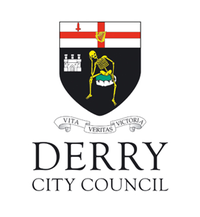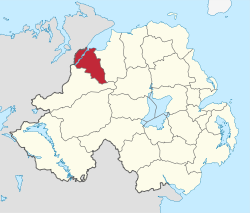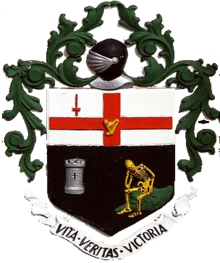- Derry City Council
-
Derry City 
Coat of Arms and LogoGeography 
Area
- TotalRanked 18th of 26
387 km²Admin HQ Derry ISO 3166-2 GB-DRY ONS code 95A Demographics Population
- Total (2010)
- DensityRanked 3rd
109,800
283 / km²Community Catholic: 75.4%
Protestant: 23.2%Politics Control No overall control
SDLP: 14
Sinn Féin: 10
DUP: 5
UUP: 1MLAs Foyle
SDLP: 3
Sinn Féin: 2
DUP: 1MPs Mark Durkan (SDLP) Meeting place The Guildhall, Derry
Website http://www.derrycity.gov.uk Derry City Council (Irish: Comhairle Cathrach Dhoire; Ulster-Scots: Derry Cittie Cooncil)[1] is a district council in County Londonderry in Northern Ireland. The Council is is responsible for the city of Derry and the immediate environ, providing services to an estimated population of 109,800 (2010), making it the third largest district council in Northern Ireland by population.
The Council is made up of 30 councillors, elected every four years from five electoral areas and holds its meetings in The Guildhall. The current Mayor of Derry is Maurice Devenney of the Democratic Unionist Party, while Kevin Campbell of Sinn Féin is the incumbent Deputy Mayor, both of whom were elected in May 2011 for a one year term.
Contents
History
Main article: History of DerryThe Council took its present name in 1984. It was known as Londonderry City Council from 1973 until 1984, and before that Londonderry County Borough (covering the city of Derry) and Londonderry Rural District (covering the rural area around Derry, roughly corresponding to the Barony of Tirkeeran). Between 1969 and 1973 both were administered by the unelected Londonderry Development Commission with the aim of creating a "new town".[citation needed]
Coat of arms and motto
The devices on the city's arms are a skeleton and a three-towered castle on a black field, with the chief or top third of the shield depicting the arms of the City of London: a red cross and sword on white. In the centre of the cross is a gold harp. The blazon of the arms is as follows:
Sable, a human skeleton Or seated upon a mossy stone proper and in dexter chief a castle triple towered argent on a chief also argent a cross gules thereon a harp or and in the first quarter a sword erect gules[2]
According to documents in the College of Arms in London and the Office of the Chief Herald of Ireland in Dublin, the arms of the city were confirmed in 1613 by Daniel Molyneux, Ulster King of Arms.[3] The College of Arms document states that the original arms of the City of Derry were ye picture of death (or a skeleton) on a moissy stone & in ye dexter point a castle and that upon grant of a charter of incorporation and the renaming of the city as Londonderry in that year the first mayor had requested the addition of a "chief of London".[4][5]
Theories have been advanced as to the meaning of the "old" arms of Derry, before the addition of the chief bearing the arms of the City of London:
- A suggestion has been made that the castle is related to an early 14th century castle in nearby Greencastle belonging to the Anglo-Norman Earl of Ulster Richard de Burgh.[3]
- The most popular theory about the skeleton is that it is that of a Norman De Burgh knight who was starved to death in the castle dungeons in 1332 on the orders of his cousin the above mentioned Earl of Ulster.[3] Another explanation put forward was that it depicted Cahir O'Doherty (Sir Charles O'Dogherty), who was put to death after Derry was invested by the English army in 1608. During the days of Gerrymandering and discrimination against the Catholic population of Derry, Derry's Roman Catholics often used to claim in dark wit that the skeleton was a local waiting for help from the council bureaucracy.[3]
In 1979, Londonderry City Council, as it was then known, commissioned a report into the city's arms and insignia, as part of the design process for an heraldic badge. The published report found that there was no basis for any of the popular explanations for the skeleton and that it was "purely symbolic and does not refer to any identifiable person".[6]
The 1613 records of the arms depicted a harp in the centre of the cross, but this was omitted from later depictions of the city arms, and in the Letters Patent confirming the arms to Londonderry Corporation in 1952.[7] In 2002 Derry City Council applied to the College of Arms to have the harp restored to the city arms, and Garter and Norroy & Ulster Kings of Arms accepted the 17th century evidence, issuing letters patent to that effect in 2003.[2]
The motto attached to the coat of arms reads in Latin, "Vita, Veritas, Victoria". This translates into English as, "Life, Truth, Victory".[3]
Mayor
Main article: Mayor of DerryThe 'Mayor of Derry', legally the 'Mayor of Londonderry' is an honorary position bestowed upon a Citizen of Derry, who is in practice a member of Derry City Council, chosen by his or her peers on the Council to serve a one year term. The Mayor is Chairman of the Council as well as the City's first citizen. The Mayor is Maurice Devenney of the Democratic Unionist Party, while Kevin Campbell of Sinn Féin is the incumbent Deputy Mayor, both of whom were elected in May 2011.
The post has a long history. A provost was appointed in the initial city charter of 1604. In 1613, this post was replaced with that of mayor, with John Rowley being the first to serve.[8] The City charter of 1665 which provided:
“ And further we will, and by these presents for us our heirs and successors do grant and ordain, that for ever hereafter there be and shall be within the city of Londonderry aforesaid one of the more honest and discreet citizens of the said city, or of the more honest and discreet inhabitants within the liberty of the same, in form hereafter in these presents mentioned, from time to time to be elected, who shall be and called the mayor of the said city.[9] ” During much of its history, it has been held by Unionists (largely due to the practice of gerrymandering)[10], but in recent years, the majority of mayors have been nationalists, reflecting the make-up of the city's current population.
From 1921 until 1969, the Mayor was automatically entitled to a seat in the Senate of Northern Ireland.
Political makeup
Since 1973 elections to Derry City Council have been conducted under the single transferable vote system, and are normally held every four years. The last elections to Derry City Council were held on 5 May 2011, with the City's voters electing thirty councillors across five electoral areas. The election resulted in all four parties returning the same number of seats they had won in the 2005 elections, with the SDLP remaining the largest party, only two seats short of overall control of the Council[11]. The results are summarised below:
Party 2011 +/- 2005 2001 1997 1993 1989 1985 Social Democratic and Labour Party 14 = 14 14 14 17 15 14 Sinn Féin 10 = 10 10 8 5 5 5 Democratic Unionist Party 5 = 5 4 4 5 4 5 Ulster Unionist Party 1 = 1 2 3 2 3 5 Other 0 = 0 0 1 1 3 ‡ 1 † Notes: † Irish Independence Party (1985 = 1); ‡ Ulster Democratic Party (1989 = 1)
Local politics
Prior to 1969, elections to the Londonderry county borough council were based on block voting. The electoral wards had been drawn and redrawn to ensure a unionist majority on the council even though more voters supported nationalist and republican parties.[12] With local government reorganisation in 1973, the old county borough was merged with the surrounding Londonderry Rural District to form the new local government district of Londonderry. In addition, a system of STV was introduced which has resulted in a majority of councillors from nationalist and republican parties being elected, with the SDLP consistently being the largest party. Curiously, in 1973 (although not in later years) this was despite the fact that unionists (who had an electoral pact in that year) and the Alliance Party of Northern Ireland won a majority of votes between them. This was in part because the strong nationalist majority within the old county borough area was diluted by the narrow unionist majority within the surrounding rural district.[citation needed]
The Derry/Londonderry name dispute affected the council, notably in 1984 when it decided to rename itself from 'Londonderry City Council' to 'Derry City Council'; this was purely a name change and its powers remained that of a district council. At the same time[citation needed] it changed the name of the municipally-owned airport from 'Londonderry Eglinton Airport' to 'City of Derry Airport'. At that time it did not seek to change the name of the city from 'Londonderry' in its charter. The name change led to a temporary unionist boycott of the council which was broken by two UUP councillors, Jim Guy and David Davis. They were expelled from their party for this but successfully contested the subsequent elections as Independent Unionists. Unionists also called for the establishment of a separate "Waterside" council covering the East Bank and rural areas, but this was rejected by the Local Government Boundary Commission in 1991.[citation needed] In 1993, David Davis lost his seat with the result that there were no unionist councillors from the West Bank, and in 2005 for the first time, no unionist stood for election in the West Bank.
The Derry City Council area is largely coterminous with both the Foyle UK Parliament constituency (first used in 1983) and the Foyle Northern Ireland Assembly Constituency (first used 1996). The MP is Mark Durkan, who was first elected in 2005 most recently returned in the 2010 General Election. He is also a former leader of the Social Democratic and Labour Party (SDLP) (2001–10) and was a MLA for the constituency from 1998 to 2010. In the 2011 election, the constituency's voters returned 3 SDLP, 2 Sinn Féin and 1 DUP members of the Northern Ireland Assembly.
Boundary changes for future Parliamentary and Assembly elections will transfer two wards in the east of the district from the Foyle constituency to the East Londonderry constituency, whose current MP is the DUP's Gregory Campbell.[citation needed] While these wards have a Catholic majority according to the 2001 Census, they are less Catholic than the rest of the city while being more Catholic than the average for East Londonderry. The net effect of the transfer is likely to be to increase the nationalist percentage of the electorate in both constituencies. This minor transfer is unlikely to have a partisan effect on either constituency in Westminster or Northern Ireland Assembly elections.[13] These changes will not affect the boundaries of the City Council.
Shadow Council
Derry/Londonderry also has a Shadow Council. This is made up from 16–22 year olds elected from geographical areas in the city, as well as interest, political groups and also GLBT community groups. The Shadow Council work in unison with DCC (Derry City Council) to lend a voice to the young generation of Foyle, who make up a large percentage of the population. The Shadow Council elect a Junior Mayor as their representative to the media and public. The current Junior Mayor is Shadow Councillor Emmet Doyle, with Kerri Anderson as deputy. Derry City Shadow Council has been copied throughout Northern Ireland with other areas taking up the idea following their example[citation needed].
2005 election results by electoral area
Cityside
Cityside[11] Party Candidate 1st Pref Sinn Féin Peter Anderson 997 SDLP Pat Ramsey 980 Sinn Féin Patricia Logue 801 Sinn Féin Barney O'Hagan 763 SDLP Jim Clifford 722 Sinn Féin Kevin Campbell 696 Independent Gary Donnelly 493 SDLP Liam Boyle 488 Socialist Environmental Liam Friel 182 Turnout 6,344 No change Northland
Northland[11] Party Candidate 1st Pref SDLP Mark H. Durkan 2,369 Sinn Féin Gerry MacLochlainn 1,124 SDLP Helen Quigley 1,079 Sinn Féin Billy Page 1,001 Sinn Féin Maeve McLaughlin 849 SDLP Seana Hume 788 SDLP John Kerr 653 SDLP Sean Carr 637 Sinn Féin Joanne McDaid 630 Sinn Féin Sharon Duddy 486 Socialist Environmental Colm Bryce 353 Socialist Environmental Oisín Kehoe 221 Turnout 10,470 No change Rural
Rural[11] Party Candidate 1st Pref Democratic Unionist William Hay 1,413 SDLP Thomas Conway 1,368 Democratic Unionist Maurice Devenney 1,275 Sinn Féin Paul Fleming 1,137 SDLP Liam Boyle 1,015 SDLP James McKeever 675 Sinn Féin Thomas McGlinchey 623 Ulster Unionist Ernest Hamilton 533 Ulster Unionist Earl Storey 450 SDLP Thomas Harty 381 Socialist Environmental Eamonn McCann 371 Independent Annie Courtney 369 Turnout 9,817 Democratic Unionist gain from Ulster Unionist Shantallow
Shantallow[11] Party Candidate 1st Pref SDLP Mary Bradley 2,180 SDLP Colum Eastwood 1,311 Sinn Féin Elisha McLaughlin 1,264 Sinn Féin Gearóid Ó hEára 1,119 SDLP Shaun Gallagher 1,119 Sinn Féin Tony Hassan 925 Sinn Féin Oliver Green 798 SDLP Helena Kearney 627 Independent Tommy Mullan 340 Turnout 9,910 No change Waterside
Waterside[11] Party Candidate 1st Pref Democratic Unionist Gregory Campbell 1,521 SDLP Gerard Diver 1,508 Democratic Unionist Joe Miller 1,187 Sinn Féin Lynn Fleming 1,084 Ulster Unionist Mary Hamilton 1,017 Democratic Unionist Drew Thompson 986 Democratic Unionist Mildred Garfield 883 SDLP Martin Reilly 567 Sinn Féin Jim Logue 447 Socialist Environmental David McAuley 194 Turnout 9,602 No change See also
- Derry
- Mayor of Derry
- Derry Urban Area
- Local Councils in Northern Ireland
- Northern Ireland Assembly
References
- ^ Walcum Derry City Council.
- ^ a b Letters Patent certifying the arms of the City of Londonderry issued to Derry City Council, sealed by Garter and Norroy and Ulster Kings of Arms dated 30 April 2003
- ^ a b c d e Lacey, Brian (1999). Discover Derry. City Guides. Dublin: The O'Brien Press Ltd. ISBN 0-86278-596-0.
- ^ Genealogical Office, Dublin: GO Ms 60, Sketches of arms by Richard Carney, fol. 47
- ^ College of Arms, London: The Arms of Peers of Ireland and some Commoners, fol. 133d (c.1652)
- ^ L E Rothwell, An inquiry initiated by Derry City Council into the ensigns armourial and related matters of the City of Londonderry
- ^ Letters Patent ratifying and confirming the arms of the City of Londonderry sealed by Garter and Norroy & Ulster Kings of Arms dated 28 April 1952
- ^ Thomas Colby, Ordnance Survey of the County of Londonderry, p.87
- ^ Charter of the City of Londonderry
- ^ sdy60f2.tmp
- ^ a b c d e f Derry City Council 1993–2005, Northern Ireland Elections
- ^ "Background Information". CAIN Web Service. http://cain.ulst.ac.uk/events/derry/bac.htm.
- ^ "The 2004 Boundary Commission: Provisional recommendations". Northern Ireland Elections. http://www.ark.ac.uk/elections/gboun04.htm.
External links
Local authorities of Northern Ireland Antrim · Ards · Armagh · Ballymena · Ballymoney · Banbridge · Belfast · Carrickfergus · Castlereagh · Coleraine · Cookstown · Craigavon · Derry · Down · Dungannon and South Tyrone · Fermanagh · Larne · Limavady · Lisburn · Magherafelt · Moyle · Newry and Mourne · Newtownabbey · North Down · Omagh · Strabane
Categories:- Derry
- Local authorities of Northern Ireland
- Politics of Derry
Wikimedia Foundation. 2010.


